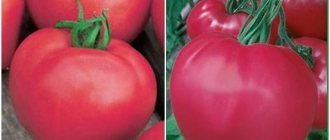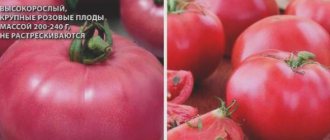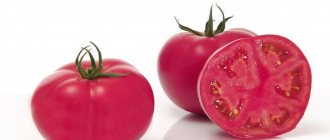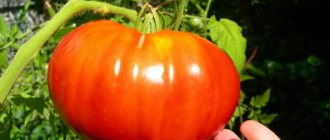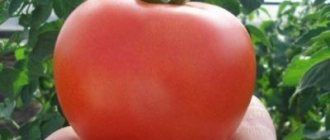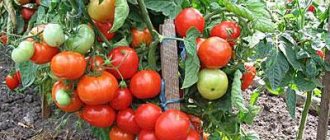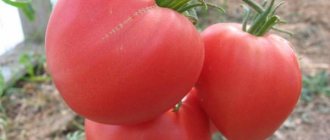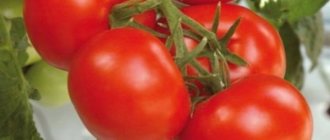Tomato Pink Rise F1 was created by Japan, and the seeds come to Russia from its French branch. The “overseas” tomato is definitely worth the effort spent on delivery - it has a great taste, beautiful pink fruits and immunity to disease.
| Height | Landing location | Ripening time | Fruit color | Fruit size | Origin | Fruit shape |
| Tall | Greenhouse | Mid-season | Pink | Large | Hybrid | Flat-round |
Description and characteristics of the variety
The name Pink Rise means “Pink Sunrise”. The hybrid was included in the State Register of the Russian Federation in 2007.
Its bushes are of indeterminate type. The fruits ripen in the middle period. They are quite large, 180-220 g each, have a rounded and slightly flattened shape with barely noticeable ribbing. They all have approximately the same aligned dimensions. There are no spots on the stalk. The color is deep pink with a slight pearl tint, the skin is glossy. The flesh is dense, but not excessively so. The taste is called the best among hybrid varieties.
Tomatoes are used for processing, fresh consumption, winter storage in canned, salted, dried and dried form, and added to various dishes. However, they are mainly considered salad vegetables.
Since Pink Rise F1 is a hybrid, you should not collect its seeds; they will not grow into a tomato with the required qualities. You'll have to buy it every time.
Features of Pink Rise tomato
Characteristics and description of the variety:
- tomatoes are grown in greenhouse conditions in all regions of our country;
- Since Pink Rise is a hybrid, tomato seeds cannot be used for sowing;
- packages of seeds must be purchased in specialized stores;
- one of the best achievements in breeding this variety is the bright pink color of the fruit both outside and inside, while its surface is smooth, glossy, with a pearl tint, and the color is uniform;
- there is no characteristic green spot around the stalk;
- the shape of the fruit is almost perfectly round, slightly flattened on top;
- the skin is smooth, sometimes there is slight ribbing;
- all tomatoes are the same size, like toy ones;
- weight of 1 tomato 180-220 g;
- the fruits on each cluster are the same size, which gives them an ideal presentation;
- the taste of the fruit is considered the best among all hybrid varieties: the flesh is pleasant, sweetish, juicy.
The fruits are used to make salads, juices, tomato purees, and are also used for preservation. The surface of the tomatoes does not crack. The fruits have excellent transportability. They can be stored for a long time.
This variety is often used for industrial cultivation and trade, as it is in high demand among buyers. The plant is indeterminate, that is, its growth is continuous and unlimited in height.
When the bush reaches the height of the greenhouse and the first ovary appears, it is pinched. The tomatoes are tied to a support. Tomatoes are planted according to a 60x40 cm pattern. There should be no dampness in the greenhouse, the room should be well ventilated. The plant needs to be watered and fertilized regularly.
See also
Characteristics and description of tomato variety Sanka, yield and cultivation
Read
This vegetable is often grown in large industrial greenhouses. No more than 3 bushes are planted per 1 m². Stepchildren are removed. The yield is 5.3 kg per 1 m². Many gardeners harvest 1.5-2 buckets of tomatoes per 1 m². This is what attracts farmers and summer residents when they choose the Pink Rise variety.
Planting and care
Seeds are sown for seedlings 55-60 days before being sent to the greenhouse. They are pre-treated to improve growth and quality. There is no need to disinfect against fungi and viruses, since purchased seeds have already undergone the necessary procedure.
To test for germination, the grains are immersed in a five percent aqueous salt solution. Good ones will sink, and bad ones will float. Then they are soaked for some time in a soda solution, which will improve the yield and quality of the fruit.
You can buy the soil in a store that has special formulations for tomatoes and peppers, or you can prepare it yourself by adding humus, peat, river sand or sawdust to the garden soil for drainage, as well as a glass of sifted wood ash and superphosphate for fertilizer. The finished mixture is spilled with a solution of potassium permanganate or calcined in an oven to kill pathogens, fungi and parasite larvae.
You should not sow the seeds right away; first, moisten the soil and let it stand for several days so that beneficial microflora develops.
The seeds are buried about 1.5 cm, sprinkled with soil, watered and covered with film. Sprout in a warm room at a temperature of +22-25 degrees. After pecking, the containers are opened and placed in a place with good lighting, where the boxes are periodically turned so that the light hits all sides of the plants.
When the seedlings have 2 true leaves, pick them. Optimally - in peat pots.
The seedlings are fed twice: the first time after picking, then some time before transplanting to a permanent place.
7-10 days before transferring to the greenhouse, the plants are hardened off.
Tomato Pink Rise F1 characteristics and description of the variety, reviews, photos of the bush
A real discovery
The real discovery of this season for me was the Pink Magic F1 tomato (a hybrid of the Japanese company Sakata).
In terms of its taste, it surpassed all varieties of raspberry varieties (even the best!) and turned out to be fleshy, sweet, with a perfectly balanced taste! The skin is dense but thin; The fruits do not crack, have a good appearance and lie perfectly. Tomatoes of this variety can be picked at technical ripeness and safely left to ripen until December. It is believed that the yield of this hybrid is average, but I have already harvested from one bush during the season more than 20 kg of beautiful, even and large fruits weighing from 250 g each. The only “but” that should be kept in mind for those who love large-fruited tomatoes: I planted only one plant per 1 m2, although 2 - 3 are recommended.
The bush itself is powerful, the leaves are large - in fact, like the fruits. I grew these tomatoes myself through seedlings, and in my polycarbonate greenhouse they grew up to 2.5 m.
Maintenance in the greenhouse was standard: the soil was mulched with straw, under which drip watering was carried out (every day in the early morning for an hour). Once every 2 weeks I fed it with wood ash. 'Pink Magic' tomatoes go well in salads, but in my family they are eaten plain, cut into slices. They are gorgeous! The taste and aroma of real tomatoes!
Review of tomato Pink
The author of the variety is a well-known agricultural company in Russia. Its specialists created the Pink tomato with the support of the Research Institute of Indoor Vegetable Growing. An application to the variety testing commission was submitted in 2005, and the following year the variety was included in the State Register of Breeding Achievements.
The author of the Pink variety is agro
In addition to Pink from, other Pinks from domestic, Dutch, and Japanese producers are registered and sold in Russia: Pink Bush, Pink Magic, Pink Paradise, Pink Pioneer, Pink Rise, etc. All these are different tomatoes, which have one thing in common - the pink color of ripe fruits.
Many topics have already been created on forums where gardeners compare tomatoes that have the word “Pink” in their names. The variety from "Gavrish", like each of them, has its pros and cons.
Pink was not created for industrial cultivation. It is designed for amateur vegetable growers who value not only tasty, but also beautiful fruits. Thanks to the early ripening of this tomato, your labor costs are reduced, you will have to water and feed less. Pink doesn't need protection from disease.
For the salad
For preparing salads, the early hybrid 'Pink Paradise F1', also raspberry inside and out, but with green seeds, turned out to be an excellent choice. The fruits are incredibly tasty and juicy, but, unlike the previous variety, they are not so large, weighing from 120 to 250 g maximum, and they need to be used quickly: they will not last long.
Description of the variety
The Pink variety has so many advantages that I immediately want to voice its main drawback - its modest yield (3.9–4.4 kg/m²) against the backdrop of a tall bush (1.5 m). For comparison: the average yield of the hybrid Pink Beauty (“Sakata”) is 8.9 kg/m², Chukhloma (“Gavrish”) is 7.9–9.6 kg/m², and the famous White Filling, whose bushes are half as tall, is 4–8 kg/m².
Otherwise, Pink is just a perfect tomato. Specialists from the State Commission for Variety Testing rated its quality and taste as “excellent.” Pink tomatoes are delicious and incomparable in a fresh salad. In addition, Pink is great for winter preparations.
The variety was created for cultivation on personal plots and garden plots under film covers. The fruits ripen 93–96 days after emergence, that is, Pink is an early tomato. Thanks to this property, it avoids late blight and manages to harvest in July - early August. The tomatoes are round, medium-sized - 120-125 g each, unripe ones are colored light green, ripe ones - bright pink without a spot at the stalk. Each cluster bears 6 fruits.
The variety is zoned for the regions of the European part of Russia, but this does not stop gardeners. Pink is grown beyond the Urals in greenhouses and even in open ground. As for the unimpressive productivity, it can be increased by competent agricultural technology. So, the creator of this tomato, if you follow simple rules, promises a yield of 3–4 kg per bush, and there can be 5–6 of them per 1 m2.
Features of cultivation
Pink is grown through seedlings. Sow the seeds in early or mid-April so that the plants are 30–35 days old by the time they are planted in the greenhouse. Disinfection of seeds and soil can be neglected, since the crop will be ready for harvest in the summer, before the period when tomatoes begin to be massively affected by late blight.
Tomato variety Pink is best grown through seedlings
At the stage of the first true leaf, pick up the seedlings. Due to the very short seedling period, you can do without fertilizing at all or apply one a week after picking, but no later than a week before planting in a permanent place. Use special fertilizers for seedlings:
If the sowing was done immediately in a greenhouse or greenhouse, then you can feed it with a natural infusion of nettle, bird droppings or mullein. But the smells of such fertilizers are not suitable for a city apartment.
There are 2 options for preparing for landing:
- A week before planting seedlings, add well-rotted humus or compost to the ground - a bucket per 1 m² - and a glass of ash for the same area. Dig up the soil with fertilizers, level it and water it.
- On the day of planting fertilizer, add a handful of humus and 1 tbsp to each hole. l. ash, you can use special mixtures for tomatoes (Red Giant, Gumi-Omi), mix with soil. Then fill the holes with water, wait until it is absorbed, and start planting.
The layout for Pink is 30x50 cm.
The distance between tomato bushes should be 30 cm
Resistant varieties
'Ottawa 30', 'Grotto', 'Explosion', 'Dubrava' and 'Yamal 200'. In general, all super-early tomatoes can be called relatively resistant, since they can be harvested before they are affected by late blight. But as for many popular varieties among gardeners, such as 'Novichok', 'Gruntovoy Gribovsky', 'Khurma', 'Stambovy Alpatieva', 'Talalikhin', 'Otradny', 'Yantarny', 'Yellow Plum', they are like They are one of the most susceptible tomatoes to late blight.
Despite the fact that our experience with tomatoes turned out to be, at first glance, very sad, there were still four tomatoes that did not disappoint: most of their fruits did not turn black, but remained healthy. These are 'Pink Magic', 'Indio', 'Gnome' and 'Explosion'. Have a good harvest!
Mid-season 'Indio'
Three years ago I accidentally bought the seeds of the mid-season hybrid 'Indio F1' from the same Japanese series of tomatoes and now I plant it constantly. The fruits are plum-shaped, red, weighing 150 g. The plant is short - 70 cm in open ground and up to 1.2 m when grown in a greenhouse.
The taste of the fruit is wonderful, perfectly balanced in both acidity and sweetness. This hybrid is very reliable - in any weather conditions you will not be left without tomatoes. When late blight is raging, it lasts the longest, and you have time to remove the fruits for ripening, and its shelf life is good (I keep it in a cool basement until the end of November).
A real discovery
The real discovery of this season for me was the Pink Magic F1 tomato (a hybrid of the Japanese company Sakata).
In terms of its taste, it surpassed all varieties of raspberry varieties (even the best!) and turned out to be fleshy, sweet, with a perfectly balanced taste! The skin is dense but thin; The fruits do not crack, have a good appearance and lie perfectly. Tomatoes of this variety can be picked at technical ripeness and safely left to ripen until December. It is believed that the yield of this hybrid is average, but I have already harvested from one bush during the season more than 20 kg of beautiful, even and large fruits weighing from 250 g each. The only “but” that should be kept in mind for those who love large-fruited tomatoes: I planted only one plant per 1 m2, although 2 - 3 are recommended.
The bush itself is powerful, the leaves are large - in fact, like the fruits. I grew these tomatoes myself through seedlings, and in my polycarbonate greenhouse they grew up to 2.5 m.
Maintenance in the greenhouse was standard: the soil was mulched with straw, under which drip watering was carried out (every day in the early morning for an hour). Once every 2 weeks I fed it with wood ash. 'Pink Magic' tomatoes go well in salads, but in my family they are eaten plain, cut into slices. They are gorgeous! The taste and aroma of real tomatoes!
Fight against late blight
Separately, I would like to talk about a problem that has been troubling many summer residents for a long time - late blight. This is a real headache for tomato lovers. Late blight - a dangerous, I would even say, harmful disease - has been very widespread lately, because it is because of it that the tomatoes in your garden rot on the drying bush, when it is time to harvest! The cooler and wetter the summer, the higher the likelihood of infection.
Tired of fighting late blight with chemicals, last season we decided to conduct a small experiment and sowed our small plot with different varieties of tomatoes in order to find the most resistant to the disease. We prepared thoroughly: we dug up the ridges in the fall, added fertilizer, and in the spring we grew gorgeous seedlings.
To all this it is worth adding that we selected the varieties themselves carefully, specially selecting seeds of early-ripening, disease-resistant tomatoes from the best producers, and bought them only in trusted stores. The result was about 30 varieties. Among them were 'Novichok', 'Stambovy Alpatieva', 'Drive', 'Life', 'Simona', 'Talalikhin', 'Katya', 'Irishka', 'Persimmon', 'White filling', 'Yellow plum', 'Gruntovoy Gribovsky' and others.
And in general, are there any varieties in nature that can withstand such an insidious and dangerous villain as late blight?
Review of tomato Pink
The author of the variety is a well-known agricultural company in Russia. Its specialists created the Pink tomato with the support of the Research Institute of Indoor Vegetable Growing. An application to the variety testing commission was submitted in 2005, and the following year the variety was included in the State Register of Breeding Achievements.
The author of the Pink variety is agro
In addition to Pink from, other Pinks from domestic, Dutch, and Japanese producers are registered and sold in Russia: Pink Bush, Pink Magic, Pink Paradise, Pink Pioneer, Pink Rise, etc. All these are different tomatoes, which have one thing in common - the pink color of ripe fruits.
Many topics have already been created on forums where gardeners compare tomatoes that have the word “Pink” in their names. The variety from "Gavrish", like each of them, has its pros and cons.
Pink was not created for industrial cultivation. It is designed for amateur vegetable growers who value not only tasty, but also beautiful fruits. Thanks to the early ripening of this tomato, your labor costs are reduced, you will have to water and feed less. Pink doesn't need protection from disease.
